Menus
- Little Queen
- Revamped this year, the 600 GSXR follows in the footsteps of its big sister 750 cm3 from which it borrows the dress and even all the accessories. She takes the opportunity to save money and sell herself at a lower price of € 1,500. Suddenly (of the cost!), As with the Midelton, the princess could…
- Presentation
- In the saddle
- City
- Departmental
- National
- Highway
- On track ! ! ! ! ! ! ! ! ! !
- Braking
- Practical aspects
- Conclusion
Little Queen
Revamped this year, the 600 GSXR follows in the footsteps of its big sister 750 cm3 from which it borrows the dress and even all the accessories. She takes the opportunity to save money and sell herself at a lower price of € 1,500. Suddenly (of the cost!), As with the Midelton, the princess could overshadow the queen ….

Presentation
The first 600 GSXR appeared in 1997, under the vintage “SRAD” for connoisseurs (SRAD: Suzuki Ram Air Direct, Ram meaning to force in). This version of the GSXR marked a return to "true values" after years of wandering. The 96/97 model indeed reconciled with happiness, lightness and handling. It was also distinguished by the arrival of voluminous dynamic air intakes, the famous SRAD. At that time, 600 and 750 differed more clearly than today: identical bodies for the two models, but classic fork and swingarm without reinforcement made it possible to distinguish certainly the 600 from the more richly endowed 750 (inverted fork and reinforced swing arm). In 1998, while the 750 adopted injection, the 600 kept carbs to play well placed in price. Its power nonetheless dropped from 107 to 110 horsepower, while it posted 201 and 203 kilograms, respectively, all full on the scale. 15 years later, its heiress copied the GSX-R 750 line for line, while it developed 126 horsepower for just 188 kilograms with full tank. The times are changing !
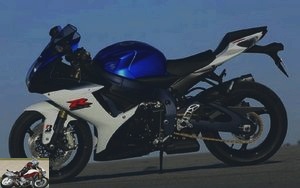
The forks are of course inverted, the brakes are radial and the look more modern, although it doesn’t have the aggressiveness of a Yamaha R6. On the equipment side, we note the appearance of a shifligth, and a gear indicator engaged. But without going back in time, the 600 GSXR 2011 marks a fine evolution from the 2010 model. Aesthetically, first of all by abandoning its 3 front headlights with very wide eyes in favor of a single optic in the central position. An evolution that takes a little back to the 2004 vintage, which means that in a way, the design of the GSXR is going a little in circles.
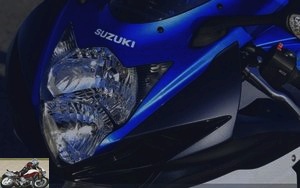
There are also more closed fairings which should promote top speed, as are the turn signals integrated into the mirrors.
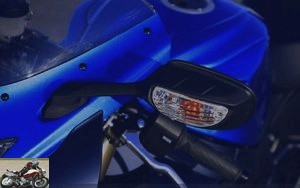
By the way, the new bodywork allows a weight gain of 3.4 kg. Spectacular! And precisely since we are talking about weight, the 2011 600 has lost 9 kg in all and made a serious refocusing of the masses to improve its behavior. Judge for yourself: wheelbase reduced by 15 mm, front shorter by 55 mm (!) While the rear lost 35 and the engine was straightened by 3 ° precisely to gain in compactness. Although hardly noticeable, the frame and swingarm are also brand new: weighing 1350 g and 900 g less on the scale, respectively. Same fight for the fork (BFP technology, for Big Piston Fork which designates above all a more economical construction process) which weighs 860 g less than the old one while the Brembo monobloc calipers weigh between them both 810 g less than the alumni Nissin. When we say that they have worked on centering the masses, it is not wrong !
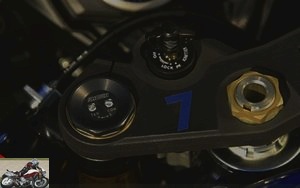
In the saddle
Still less radical than its competitors, the 600 GSXR is also more welcoming. The driving position is not too extreme and the rider easily finds his place without breaking into 2. It also has adjustable footrests, which is worth pointing out. He has a classic yet very readable dashboard before him, which is not necessarily systematic in other supersports. We really like the gear indicator engaged as well as the shiftlight with several diodes, also clearly visible. The red zone starts at 15,250 rpm…. (unlike the 750 pictured here which starts 1000 rpm earlier) it’s just that these little beasts are spinning, but technical miracle, it’s super reliable! Go hop, on the way !
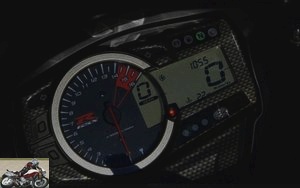
City
Reworked for more flexibility and torque, the small 4-legged takes advantage of lighter pistons to better respond to the grip, take even more turns and also reduce the amplitude of vibrations. A work of reducing friction losses, a new exhaust and a revised electronics (with 2 modes available but hardly useful) make it gain a chouïa in performance: 0.1 mkg and almost 1 hp, that is to say not much . But in fact the engineers mainly sought to improve the behavior at low and mid-range and it is therefore in town that we also benefit from the good character of this 600. Discreet at low speed, very flexible, steering relatively correctly for a hypersport, it is ultimately very civilized on a daily basis. Not too stretched out, the driver manages to lift his head to navigate the flow of cars, taking advantage of a gearbox and smooth controls. Even if it’s not heaven, neither is it hell, quite the contrary.

Departmental
Here we begin to see the other aspect of the work of engineers: weight reduction. On small roads, the 600 GSXR swings more easily than its predecessor and also benefits from better engine response on relaunch, both thanks to weight and better engine availability. We also perceive at the same time the braking which offers more bite. In terms of comfort, it’s all relative, but frankly, the little "Gex" does not have to be ashamed of the competition, it is even placed very high in the basket. The sketch that emerges here already makes us want to know more ….
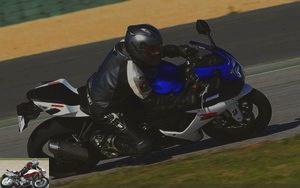
National
We increase the pace a little, but it always follows without problem. The new chassis has not lost any rigidity and the big curves are swallowed at high speed without a hitch. We feel that the beauty likes it and even asks for more. We always appreciate this perfectly balanced sport / comfort versatility which allows the rider to appreciate his sport also on the road. Taking advantage of the wide open spaces, the engine takes endless revolutions, leaving a hoarse voice muffled by a loud intake noise that makes you think at first that someone is catching up with you… .. But it’s impossible, on its handlebars you are unbearable ! ! ! !
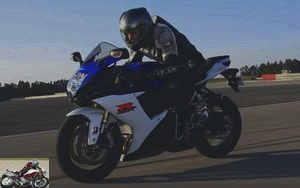
Highway
You can always go for a ride across the Rhine to "shoot a ball". You’ll happily pass the 250 qualifiers, benefiting from improved aerodynamics and relatively decent protection. While lying down with your head on the tank, you will still have your ears a little stuffed with the noise of the engine intake, but if not, again, it is not worse than on the competitors who tear your arms out and break your head. neck. Definitely, this new GSXR is ultimately very livable on a daily basis !
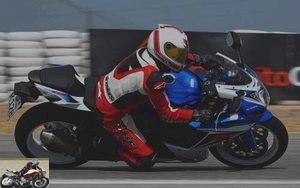
On track ! ! ! ! ! ! ! ! ! !
Here you will feast and appreciate all the relevance of the work carried out by Suzuki engineers. We do not know where to start because it is better everywhere! The work of lightening has of course borne fruit, but it is transcended by the effort made on centering the masses. Because if the bike is lighter, it also benefits from a lower polar inertia which makes it much more lively. To explain the influence of the centering of masses, imagine two people who each carry a mass of 10 kg. In one case, this mass is made up of a long ladder and in the other it is concentrated in a securely stowed backpack. If these two people are made to make rapid maneuvers with changes of direction, the one carrying the backpack will be more lively in its twists and turns than the one carrying the ladder, because it has less "polar inertia. ". The new 600 GSXR is the same, it is much more lively than the old one in the angle setting and in the sequences of the style "pif-paf". The same goes for the steering, which benefits from a lighter wheel, tire, fork and calipers (just that!). It’s really livelier and more efficient. In fact, the 600 GSXR quickly gives its rider confidence, even if he is not a pro. The entry speeds into curves are high and after having touched the point of the rope that you are aiming for, you wring out the handle copiously on exit. It should be noted, however, that our test bike was fitted with Metzeler Sportec M5 tires instead of the original BT 16 AAs. Maybe this has a slight influence. Our 600 was actually very easy and playful, much more than the 750 we tested in Cartagena. Here too two explanations must be taken into account. On the one hand, the 750 had been modified without our knowledge (rear raised by chocks, see test), which apparently distorted its behavior a lot. In addition, in addition to its additional 4 kg, the 750 is distinguished by a higher engine stroke (70 X 48.7 against 67 X 42.5) which induces an increased gyroscopic effect, also making the 750 less maneuverable than the 600.
And the engine will you say correctly? He behaves very well too! Well filled for a 600, it offers a good range of use and howls with pleasure when taking turns. It’s really very nice and again easy to use.
Braking
The monobloc calipers ensure flawless braking with a very good feeling, despite the rubber hoses. A shame because the 1000 GSXR admits it a real weakness in this area. The explanation is simple: heavier and faster, it does not have the famous Brembo calipers! ! ! Yet it is sold 3300 € more! Benefit from the centering of the masses (again), the braking stability is excellent.
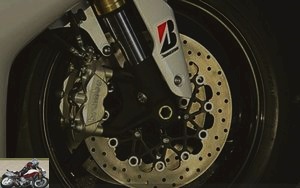
Practical aspects
Civilized as it is, the 600 GSXR remains a pure sports car, which shouldn’t be asked too much either. If it takes care of the comfort and the position of the pilot, it will be less delicate with the passenger, perched with the legs very bent. Unless you have a dancer as a companion (they are flexible and usually petite), you risk divorce if you plan a camping vacation in southern Spain. When it comes to transporting luggage, it is also very limited. Your passenger will also have to carry the backpack…. There are still 2 crutches, but the second is under the tank to keep it raised when working on the engine. Under the saddle, you will house a small U, and maybe a bunch of small LUs, but not much more. The suspensions are of course adjustable in all directions, which allows you to go from the track to the road with the same happiness..
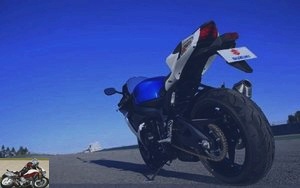
Conclusion
As much as the 750 GSX-R left us hungry for lack of poor chassis tuning, this 600 won us over with its ease and the good feeling it gives off. On his handlebars, you don’t have to be a great rider to get your feet wet. We are immediately confident and we will happily tease the limits. Undoubtedly the 750 would also have seduced us under the same conditions, but we have to admit that at 11,999 € this 600 offers a significantly higher price / performance / sensation ratio even if in 2010 the list price difference which was 2000 € is now reduced to 1500 €! But except for a few details related to the larger displacement (silencer, gearbox, etc.) the 600 and 750 are identical to the power and the torque: 24 hp and 1.9 mkg. If you drive at 100 hp, it is therefore only on the torque that you will make the difference and as we said, even on the track this 600 is doing very well. So for us, except to prefer the prestige of a visually identical 750, we advise you to adopt the 600 without hesitation, because it really offers excellent value for money. Especially since with the difference in price, you have enough to pay yourself a few sets of tires and driving courses to tax the 750 on the track…
Strong points
- ease of use
- braking and braking stability
- Voluntary motor
- Good quality / price / performance ratio
Weak points
- Unnecessary selectable modes
- the sacrificed passenger
- the look a little too consensual
Competitors: Honda
CBR 600, Kawasaki ZX6R 636, Triumph Daytona 675, Yamaha
R6
Datasheet
Related articles
-
Track test: An R1 or Nothing ? Queen of beauty, the R1 has won over many bikers with its plastic and dynamic qualities. In 14 years of existence it has…
-
Honda CRF 250 L motorcycle test
A little trail that sparkles The great Escape You don’t like small cars? So be sure to read this article! Because after discovering this new Honda, you…
-
Suzuki GSX-R 750 motorcycle test
Out of category champion A true modern icon of motorcycling sport, the 750 GSXR pursues its solo career, without however ever visiting the paddocks or…
-
Triumph Daytona 675 R motorcycle test
Track test: a higher R The Triumph sports range now begins and ends at 675 cc since the disappearance of the Daytona 955 (which was not a true hypersport…
-
Suzuki GSX-R 1000 motorcycle test
A friend who wants you well First appearing in 2000, the GSXR 1000 will quickly establish itself as a sporting stallion for a long time. But in the face…
-
Single cylinder, 4-stroke, 124.4 cm3, 15 hp at 10,000 rpm, 11.5 Nm at 8,000 rpm, 134 kilos, € 4,599 A little sportswoman who worthily represents the…
-
Yamaha Thunderace 1000 YZF motorcycle test
Biker test: Jean-Michel I my name is Jean-Michel (JeanMi for close friends), from 42 but today in the 74 for professional reasons. I have 23 years old…
-
Triumph Street Triple 765 RS motorcycle test
The Moto2 roadster 3-cylinder engine, 765 cc, 123 HP, 79 Nm, 166 kg dry, € 11,900 Since its release in 2007, the Street Triple has been a real commercial…
-
Small (Force of) strike ! Unchanged since 2010, the Yamaha R6 remains a benchmark in the Supersports segment. Light and radical, it is as pleasant on the…
-
The big Suzuki trail passes Euro 4: 101 hp, 101 Nm, € 13,299 ABS corner and cosmetic developments for this truly versatile machine We can live a world of…